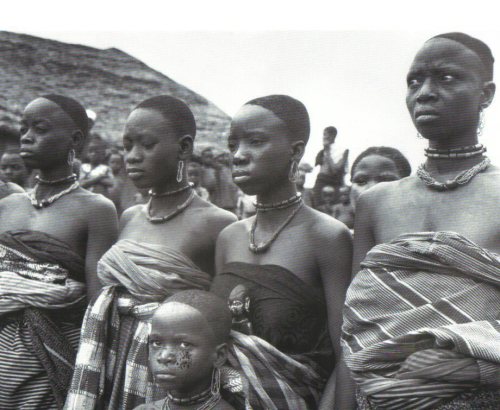Post by alaujani on Jan 16, 2013 4:22:13 GMT -5
dienekes.blogspot.com/2012/03/effects-of-ascertainment-on-admixture.html
The effects of ascertainment on admixture estimates
In a previous experiment, I discovered a clear signal of West Eurasian-like admixture in Sub-Saharan African populations, using a set of markers ascertained in a San individual. The marker panels of the Harvard HGDP dataset have been ascertained on different individuals from around the world, and so they are very useful in showing the effects of ascertainment on admixture estimates.
I have repeated the same K=5 experiment, using the ascertainment panels on a French, Han, Papuan1, San, and Yoruba individuals. Irrespective of the panel used, the same five components emerged: Asian, West-Eurasian, African, Australasian, and Amerindian. However, there are substantial differences in the inferred admixture proportions. The average admixture proportions can be found in this spreadsheet.
The levels of the "African" component in the HGDP African populations are summarized below:

These are almost the same in the French/Han/Papuan1 ascertainments, despite the different number of markers used. When SNPs are ascertained on Eurasian individuals, many SNPs present in African populations are not discovered, and hence, African populations appear "purer" by having a higher proportion of the "African" ancestral component.
However, when SNPs are ascertained on African populations, a different picture emerges, with clear evidence of West Eurasian admixture:
San ascertainment:

Yoruba ascertainment:

It is now evident that there is Eurasian admixture in African populations that was "hidden" in panels of SNPs ascertained on Eurasian individuals. Moreover, this Eurasian admixture seems to be more related to West Eurasians.
Someone might argue that the observed West Eurasian admixture in African populations is the result of a second migration Out-of-Africa that only affected West Eurasians. This, however, is a weak argument, because -with the exception of a few populations with known recent African admixture, such as the HGDP Arabs- there is no variation in African ancestry in Eurasia: it is everywhere virtually zero. On the contrary, in Africa, there are populations with a lot of West Eurasian admixture (Mozabites), intermediate (Yoruba, Bantu) and minimal (San, Pygmies). If the HGDP included more East African and Saharan populations, we would see an even clearer view of variable West Eurasian admixture throughout Africa. In short: the variable levels of West Eurasian admixture in Africa, coupled with the constant lack of any substantial African admixture in West Eurasia is a tell-tale sign that it was a West Eurasia-to-Africa migration, and not the reverse.
This migration created a cline of West Eurasian admixture in Africa, with minima in isolated African hunter-gatherer (San/Pygmy populations), maxima in North and East Africa, and sharp transitions across geographical barriers (such as the Sahara), or ethnic differences (e.g., African agriculturalists vs. foragers). It is no longer tenable to view West Eurasian back-migrations as limited events that affected only North and East Africa: their effects are clearly evident throughout Africa, having affected different populations to a different extent.
The existence of Eurasian admixture throughout Africa is an interesting and novel finding. How much such admixture is there? As I explain here, in the case of admixed populations, the proportion of foreign admixture of a population increases if we include "purer" indigenous populations: Mexican Mestizos are less "European" if remote Amazonians are included in the analysis; North Indians appear more "South Asian" if South Indian tribals are excluded.
The African hunter-gatherers (San and Pygmies) are the least admixed Africans currently in existence, but we cannot tell what their proportion of indigenous African vs. Eurasian ancestry actually is. We simply don't have the genomes of pre-back-migration Africans to compare against, although there are strong hints from palaeonathropology that these included forms that do not fit within the present-day Homo sapiens continuum, such as Iwo Eleru.
It is at present unknown what percentage of African genomes is derived from Eurasian back-migrants, anatomically modern humans in Africa, as well as more divergent indigenous African hominins.
Hopefully the techniques of "virtual genomes", inference techniques allowing migration, such as TreeMix, together with full genome sequencing, and (hopefully) ancient African DNA will help elucidate the emerging picture of the multiple origins of the Sub-Saharan Africans. Africa may have been the cradle of H. sapiens but many of her Eurasian sons came back.
The effects of ascertainment on admixture estimates
In a previous experiment, I discovered a clear signal of West Eurasian-like admixture in Sub-Saharan African populations, using a set of markers ascertained in a San individual. The marker panels of the Harvard HGDP dataset have been ascertained on different individuals from around the world, and so they are very useful in showing the effects of ascertainment on admixture estimates.
I have repeated the same K=5 experiment, using the ascertainment panels on a French, Han, Papuan1, San, and Yoruba individuals. Irrespective of the panel used, the same five components emerged: Asian, West-Eurasian, African, Australasian, and Amerindian. However, there are substantial differences in the inferred admixture proportions. The average admixture proportions can be found in this spreadsheet.
The levels of the "African" component in the HGDP African populations are summarized below:

These are almost the same in the French/Han/Papuan1 ascertainments, despite the different number of markers used. When SNPs are ascertained on Eurasian individuals, many SNPs present in African populations are not discovered, and hence, African populations appear "purer" by having a higher proportion of the "African" ancestral component.
However, when SNPs are ascertained on African populations, a different picture emerges, with clear evidence of West Eurasian admixture:
San ascertainment:

Yoruba ascertainment:

It is now evident that there is Eurasian admixture in African populations that was "hidden" in panels of SNPs ascertained on Eurasian individuals. Moreover, this Eurasian admixture seems to be more related to West Eurasians.
Someone might argue that the observed West Eurasian admixture in African populations is the result of a second migration Out-of-Africa that only affected West Eurasians. This, however, is a weak argument, because -with the exception of a few populations with known recent African admixture, such as the HGDP Arabs- there is no variation in African ancestry in Eurasia: it is everywhere virtually zero. On the contrary, in Africa, there are populations with a lot of West Eurasian admixture (Mozabites), intermediate (Yoruba, Bantu) and minimal (San, Pygmies). If the HGDP included more East African and Saharan populations, we would see an even clearer view of variable West Eurasian admixture throughout Africa. In short: the variable levels of West Eurasian admixture in Africa, coupled with the constant lack of any substantial African admixture in West Eurasia is a tell-tale sign that it was a West Eurasia-to-Africa migration, and not the reverse.
This migration created a cline of West Eurasian admixture in Africa, with minima in isolated African hunter-gatherer (San/Pygmy populations), maxima in North and East Africa, and sharp transitions across geographical barriers (such as the Sahara), or ethnic differences (e.g., African agriculturalists vs. foragers). It is no longer tenable to view West Eurasian back-migrations as limited events that affected only North and East Africa: their effects are clearly evident throughout Africa, having affected different populations to a different extent.
The existence of Eurasian admixture throughout Africa is an interesting and novel finding. How much such admixture is there? As I explain here, in the case of admixed populations, the proportion of foreign admixture of a population increases if we include "purer" indigenous populations: Mexican Mestizos are less "European" if remote Amazonians are included in the analysis; North Indians appear more "South Asian" if South Indian tribals are excluded.
The African hunter-gatherers (San and Pygmies) are the least admixed Africans currently in existence, but we cannot tell what their proportion of indigenous African vs. Eurasian ancestry actually is. We simply don't have the genomes of pre-back-migration Africans to compare against, although there are strong hints from palaeonathropology that these included forms that do not fit within the present-day Homo sapiens continuum, such as Iwo Eleru.
It is at present unknown what percentage of African genomes is derived from Eurasian back-migrants, anatomically modern humans in Africa, as well as more divergent indigenous African hominins.
Hopefully the techniques of "virtual genomes", inference techniques allowing migration, such as TreeMix, together with full genome sequencing, and (hopefully) ancient African DNA will help elucidate the emerging picture of the multiple origins of the Sub-Saharan Africans. Africa may have been the cradle of H. sapiens but many of her Eurasian sons came back.









